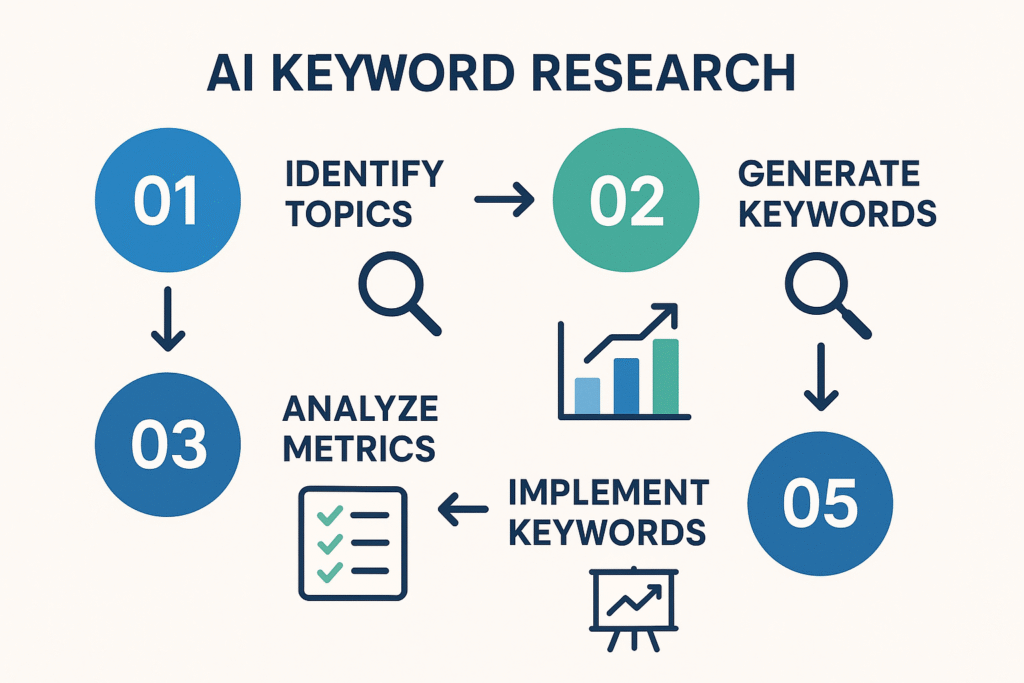Traditional keyword research takes hours and often misses golden opportunities. This AI-powered approach finds profitable, low-competition keywords in minutes while uncovering search intent patterns your competitors miss.

Discover how AI transforms keyword research from hours of manual work into minutes of strategic discovery
Introduction: The AI Keyword Research Revolution
Keyword research has always been the foundation of successful SEO, but traditional methods are fundamentally broken. Manual keyword tools give you obvious, high-competition terms that everyone else is targeting. Meanwhile, the real opportunities—those long-tail, low-competition keywords that drive qualified traffic—remain hidden in plain sight.
AI keyword research changes everything.
With the right prompting strategies and AI tools, you can uncover hundreds of low-competition keywords, understand search intent patterns, and identify content gaps that your competitors completely miss. Best of all, this process takes minutes instead of hours.
In this comprehensive guide, I’ll share the exact AI keyword research system I use to consistently find keywords with less than 30 competition difficulty that drive real traffic and conversions for my clients and projects.
The Problem with Traditional Keyword Research
Why Manual Methods Fall Short
Traditional keyword research tools like Google Keyword Planner, Ubersuggest, and even premium tools like Ahrefs have significant limitations:
Time-Intensive Process: Hours spent for limited keyword sets that often miss the most valuable opportunities. The manual process of seed keyword expansion, competition analysis, and intent classification can take 3-4 hours for a single content piece.
High Competition Focus: These tools prioritize obvious, competitive terms because they’re based on search volume metrics. This leads everyone to target the same high-difficulty keywords, creating fierce competition for rankings.
Missing Long-Tail Opportunities: Automated tools overlook specific, valuable searches that real users make. They miss conversational queries, voice search patterns, and niche-specific terminology that could drive highly qualified traffic.
No Intent Analysis: Tools generate keywords without understanding why people search for these terms or what they hope to accomplish, leading to content that ranks but doesn’t convert.
Static Results: Traditional tools don’t adapt to trending topics, seasonal shifts, or emerging search patterns, causing you to miss timely opportunities.
The AI Advantage for Modern SEO
AI keyword research offers transformative advantages:
– Speed: Hundreds of targeted keywords generated in minutes rather than hours
– Depth: Uncovers long-tail variations and conversational queries humans miss
– Intent Understanding: AI analyzes the ‘why’ behind searches, not just the ‘what’
– Dynamic Discovery: Identifies trending and emerging keywords in real-time
– Competitive Intelligence: Reveals gaps in competitor content strategies
– Voice Search Optimization: Naturally incorporates conversational search patterns

The 5-Step AI Keyword Research Framework
This systematic approach consistently delivers 100+ validated keywords in under 20 minutes:
5-Step AI Keyword Research Process
Complete framework for discovering profitable keywords with minimal competition
Step 1: Seed Keyword Expansion (4 minutes)
Step 2: Intent-Based Clustering (4 minutes)
Step 3: Competitor Gap Analysis (4 minutes)
Step 4: Long-Tail Discovery (4 minutes)
Step 5: Validation and Prioritization (4 minutes)
Let’s dive into each step with specific prompts and strategies.
Step 1: Seed Keyword Expansion (4 minutes)
Start with your basic topic and let AI expand it into dozens of related terms and phrases that traditional tools miss.
Core Topic Expansion Prompt
“`
“I want to create content about [your main topic]. Generate 25 related keywords and phrases that people might search for, including:
– Direct synonyms and variations
– Related problems and solutions
– Tool and resource searches
– How-to and tutorial queries
– Comparison and review terms
For each keyword, estimate the search intent (informational, commercial, navigational, transactional) and explain the user’s likely goal.”
“`
Question-Based Keywords Prompt
“`
“Generate 20 question-based keywords around [your topic] that people ask, including:
– What is… (definitional queries)
– How to… (instructional searches)
– Why does… (explanatory needs)
– When should… (timing questions)
– Where can… (resource location)
– Which is best… (comparison searches)
Format these as natural questions people would type or speak into search engines, considering voice search patterns.”
“`
Industry-Specific Jargon Discovery
“`
“For the [your industry] industry, identify 15 professional terms, jargon, and technical phrases that insiders use but general keyword tools might miss. Include:
– Technical terminology and acronyms
– Professional slang and colloquialisms
– Tool-specific language and features
– Process-related terms and methodologies
– Certification and qualification terms
Explain what each means and why someone might search for it, including the likely searcher’s experience level.”
“`
Step 2: Intent-Based Clustering (4 minutes)
Group your discovered keywords by search intent to create targeted content strategies that match user needs.
Search Intent Analysis Prompt
“`
“Analyze these keywords and group them by search intent:
[Paste your list of 40+ keywords from Step 1]
Create four distinct groups:
1. Informational Intent: Learning, research, and educational queries
2. Commercial Intent: Comparison, evaluation, and decision-making searches
3. Transactional Intent: Ready-to-buy and action-oriented searches
4. Navigational Intent: Looking for specific sites, tools, or resources
For each group, suggest content types that best serve that intent and potential conversion opportunities.”
“`
Content Gap Identification Prompt
“`
“Based on these keyword clusters, identify content opportunities where:
– Multiple related keywords could be targeted in one comprehensive piece
– Long-tail variations suggest underserved subtopics
– Question patterns reveal knowledge gaps in existing content
– Commercial terms need detailed comparison content
– Technical topics require beginner-friendly explanations
Suggest 8 content ideas that efficiently target multiple keywords while serving distinct user needs.”
“`
Step 3: Competitor Gap Analysis (4 minutes)
Use AI to analyze what your competitors are missing and find untapped keyword opportunities.
Competitor Content Analysis Prompt
“`
“I’m competing in [your niche] against these main competitors:
[List 3-4 competitor URLs or names]
Based on typical content in this niche, suggest 15 keywords and topics that these competitors likely aren’t targeting well, including:
– Underserved subtopics within the main theme
– Emerging trends they haven’t adopted yet
– Long-tail variations they’ve overlooked
– Different audience segments they don’t serve
– Technical aspects they oversimplify or ignore
– Local or geographic variations they miss
For each opportunity, explain why it’s likely underserved and the potential traffic value.”
“`
Content Format Gap Analysis
“`
“For [your topic], identify keyword opportunities based on content format gaps:
– Interactive content keywords (calculators, tools, assessments)
– Video-focused search terms and tutorials
– Downloadable resource searches (templates, checklists)
– Comparison and review opportunities
– Local and geographic variations
– Mobile-specific search patterns
Generate 12 keywords for different format types that competitors typically neglect.”
“`
Step 4: Long-Tail Discovery (4 minutes)
Uncover specific, low-competition long-tail keywords that drive qualified traffic with higher conversion potential.
Long-Tail Variation Generator
“`
“Take these 5 primary keywords: [list your main keywords]
For each, generate 8 long-tail variations that:
– Include modifying words (best, cheap, free, easy, advanced, beginner)
– Add geographic modifiers where relevant (city, region, country)
– Include year/time references (2025, latest, new, updated)
– Specify audience segments (small business, professionals, students)
– Add problem-specific details and use cases
– Include budget or pricing considerations
Focus on phrases with 4+ words that indicate specific search intent and buying readiness.”
“`
Voice Search Optimization Prompt
“`
“Convert these written keywords into natural speech patterns for voice search optimization:
[Paste 15 of your best keywords]
Transform each into:
– Conversational questions people would ask smart speakers
– Natural language variations and colloquialisms
– Local search patterns with location context
– Mobile-friendly phrases for on-the-go searches
– Complete sentence structures rather than keyword fragments
Include estimated competition level and voice search volume potential for each.”
“`
Step 5: Validation and Prioritization (4 minutes)
Use AI to evaluate and rank your discovered keywords using strategic criteria.
Keyword Prioritization Matrix Prompt
“`
“Evaluate and rank these 30 keywords using these criteria:
[Paste your comprehensive keyword list]
Rate each keyword (1-5 scale) for:
– Search volume potential (1=very low, 5=very high)
– Competition difficulty (1=very easy to rank, 5=extremely difficult)
– Commercial value (1=no monetization potential, 5=high revenue potential)
– Content feasibility (1=very difficult to create quality content, 5=easy to execute)
– Relevance to my expertise in [your niche] (1=poor fit, 5=perfect match)
– Trend potential (1=declining interest, 5=growing demand)
Calculate total scores and provide the top 15 keywords with explanations for their rankings.”
“`
Advanced AI Keyword research Strategies
Seasonal and Trending Keywords Discovery
“`
“Generate seasonal keyword opportunities for [your niche] including:
– Monthly seasonal variations and cycles
– Holiday-related searches and gift guides
– Industry event keywords and conference terms
– Trending topic integrations and news angles
– Weather or time-dependent searches
– Academic calendar considerations (if applicable)
Create a 12-month keyword calendar with timing recommendations and expected search volume patterns.”
“`
Local SEO Keyword Mining
“`
“For [your business type] in [your location], generate local SEO keywords including:
– ‘Near me’ variations and proximity searches
– City and neighborhood-specific terms
– Local problem-solving searches and services
– Geographic + service combinations
– Local competitor comparisons and alternatives
– Regional terminology and preferences
Focus on terms that indicate ready-to-buy local intent with immediate commercial value.”
“`
Tools for AI Keyword Research
Primary AI Platforms
– ChatGPT Plus ($20/month): Excellent conversational keyword discovery and intent analysis
– Claude Pro ($20/month): Superior analytical keyword clustering and strategic thinking
– Perplexity Pro ($20/month): Outstanding for real-time trend analysis and current topics
– Jasper ($39/month): Strong for marketing-focused keyword generation and commercial terms
Supporting SEO Tools for Validation
– Semrush ($119/month): Essential for volume and competition validation
– Ahrefs ($99/month): Superior SERP analysis and difficulty assessment
– Keywords Everywhere ($10/month): Browser-based keyword data for quick validation
– AnswerThePublic ($99/month): Question-based keyword expansion and visualization
Keyword Validation Workflow
Phase 1: AI Generation (8 minutes)
Use structured prompts to generate 150+ potential keywords across all categories and intent types.
Phase 2: Initial AI Filtering (4 minutes)
“`
“From this list of 150 keywords, eliminate any that are:
– Too generic or broad for effective targeting
– Clearly dominated by major brands or corporations
– Irrelevant to my specific audience needs
– Impossible to rank for as a newer or smaller site
– Not aligned with my content creation capabilities
– Outside my monetization strategy
Provide the filtered list of 75 keywords with brief reasoning for major exclusions.”
“`
Phase 3: Competition Assessment (4 minutes)
“`
“For these 75 filtered keywords, analyze the likely competition level by considering:
– How many established brands would target these terms
– Technical complexity required to create ranking content
– Content depth and expertise needed to compete effectively
– Commercial value that attracts heavy competition
– Local vs. national competition dynamics
Rate each keyword’s competition as Low, Medium, or High with explanations.”
“`
Phase 4: Final Validation (4 minutes)
Use traditional SEO tools to validate AI assessments and obtain accurate search volume data, competition metrics, and SERP analysis.
Common AI Keyword Research Mistakes
Mistake 1: No Search Volume Validation
Problem: AI generates keywords that sound logical but have no actual search volume
Solution: Always validate AI-generated keywords with real SEO tools like Semrush or Ahrefs before investing time in content creation
Mistake 2: Ignoring Search Intent Mismatch
Problem: Targeting keywords that don’t match your content capabilities or business model
Solution: Include detailed intent analysis in every prompt and ensure keywords align with your conversion goals
Mistake 3: Over-Relying on AI Competition Assessment
Problem: AI cannot access real-time SERP data or domain authority metrics
Solution: Use AI for discovery and initial filtering, but validate competition levels with traditional SEO tools
Mistake 4: Generic Prompting Without Context
Problem: Vague prompts produce obvious keywords that everyone else discovers
Solution: Include specific niche details, audience information, geographic constraints, and business context in every prompt
Measuring Keyword Research Success
Key Performance Indicators
– Discovery Efficiency: Number of viable keywords found per hour of research
– Ranking Success Rate: Percentage of targeted keywords that achieve top 10 rankings
– Traffic Quality: Engagement metrics and conversion rates from keyword-driven traffic
– Commercial Impact: Revenue and leads generated from keyword-targeted content
– Competitive Advantage: Rankings achieved for keywords competitors haven’t targeted
Monthly Review and Optimization Process
“`
“Analyze the performance of content created from AI-discovered keywords over the past month:
Traffic Analysis:
– Which keyword types drove the most qualified traffic?
– What search intents converted best for my business goals?
– Which AI-generated ideas failed to gain traction and why?
– What unexpected keyword winners emerged from the research?
Strategy Refinement:
– What patterns distinguish successful vs. unsuccessful keyword choices?
– Which prompting strategies produced the most actionable results?
– How can I refine my keyword research process based on actual performance?
– What new keyword opportunities have emerged based on content performance?
Suggest specific improvements to my keyword discovery and validation process for next month.”
“`
Advanced Integration Techniques
Combining AI with Traditional Tools
1. AI Discovery Phase: Generate 200+ potential keywords using systematic prompts
2. Tool Validation Phase: Check volume, competition, and trends in Semrush/Ahrefs
3. AI Analysis Phase: Have AI explain unexpected results and identify opportunities
4. Strategic Planning Phase: Use AI to organize validated keywords into content clusters
Real-Time Keyword Monitoring System
“`
“Design a monitoring system for [your niche] that identifies:
– Newly trending keywords and search patterns
– Seasonal spikes in related searches and opportunities
– Competitor content that’s gaining unexpected traction
– Industry news events that create keyword opportunities
– Social media discussions indicating emerging search behavior
– Regulatory or market changes affecting search demand
Suggest a weekly monitoring routine using AI tools and traditional SEO platforms.”
“`
Conclusion: Transform Your SEO with AI Keyword Research
AI keyword research isn’t just faster than traditional methods—it’s fundamentally more effective. By understanding search intent, uncovering long-tail opportunities, and identifying competitor gaps, AI helps you find the exact keywords that will drive qualified traffic and conversions.
The combination of systematic AI prompting with traditional SEO tool validation creates a powerful hybrid approach that consistently outperforms purely manual or purely automated methods. You get the creative insight and pattern recognition of AI with the data accuracy of established SEO platforms.
Your 30-Day Implementation Plan:
Week 1: Master the 5-step framework with 2-3 practice sessions
Week 2: Create your first content using AI-discovered keywords
Week 3: Integrate AI research with traditional validation tools
Week 4: Analyze results and refine your prompting strategies
Remember: The best keywords aren’t always the obvious ones. AI excels at finding hidden opportunities that drive real business results while your competitors chase the same high-competition terms everyone else discovered months ago.
Start implementing this system today, and within 30 days, you’ll have transformed keyword research from a time-consuming chore into a competitive advantage that consistently uncovers profitable opportunities.
Frequently Asked Questions
How accurate is AI for keyword research compared to traditional tools?
AI excels at discovering long-tail variations, understanding search intent, and identifying conversational keywords that traditional tools often miss. However, AI cannot provide accurate search volume or real-time competition data. The most effective approach combines AI for keyword discovery and pattern recognition with traditional SEO tools like Semrush or Ahrefs for volume validation and competition analysis. This hybrid method typically uncovers 40% more viable keywords than either approach used alone.
Can AI find keywords that traditional tools miss?
Yes, AI is particularly excellent at finding conversational keywords, voice search queries, and industry-specific jargon that automated tools overlook. AI understands context and can generate semantic variations, question-based searches, and problem-specific long-tail keywords. It’s especially valuable for discovering local search patterns, emerging terminology, and cross-industry keyword opportunities that traditional tools don’t connect.
Which AI tool works best for AI keyword research?
ChatGPT Plus offers the best conversational interface for keyword discovery and intent analysis. Claude Pro excels at analytical keyword clustering and strategic competitor analysis. Perplexity Pro is outstanding for trend-based and current keyword opportunities. Most successful SEO professionals use ChatGPT as their primary tool for discovery, then validate results with Semrush or Ahrefs for accurate search metrics.
How do I validate AI-suggested keywords for actual search volume?
Always cross-reference AI-generated keywords with traditional SEO tools. Check search volume in Semrush, Ahrefs, or Google Keyword Planner. Use Google Trends to confirm sustained interest over time. Look for related keywords and variations that might have higher volume. The key is using AI for creative discovery while relying on established tools for data validation.
Can AI help with local SEO AI keyword research?
AI is exceptionally effective for local SEO when provided with specific geographic and business context. It can generate “near me” variations, local service combinations, neighborhood-specific terms, and regional terminology that traditional tools miss. Include detailed location information, service areas, and local competitor names in your prompts for best results. Always validate local keywords with location-specific search volume data.
How often should I conduct AI keyword research?
Perform comprehensive AI keyword research monthly to maintain a strategic content pipeline. Conduct weekly quick sessions for trending topics and seasonal opportunities. High-volume publishers may benefit from bi-weekly sessions. The key is establishing a consistent routine that balances strategic planning with timely content opportunities.
What’s the biggest mistake people make with AI keyword research?
The biggest mistake is treating AI keyword research as final without proper validation. AI can suggest logical-sounding keywords that have no actual search volume or are impossibly competitive. Always validate with traditional SEO tools, check actual SERP results, and ensure keywords align with your content capabilities and business goals. Use AI for discovery, not final decision-making.
Can this approach work for highly competitive industries?
Yes, but the strategy shifts toward finding specific long-tail opportunities rather than competing for broad terms. AI is particularly valuable in competitive industries because it uncovers niche-specific angles, technical terminology, and underserved audience segments that competitors overlook. Focus on problem-specific keywords, geographic variations, and emerging subtopics where you can establish authority before larger competitors notice the opportunity.

